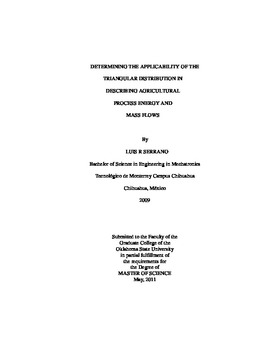| dc.contributor.author | Serrano, Luis R. | |
| dc.date.accessioned | 2014-02-25T00:21:15Z | |
| dc.date.available | 2014-02-25T00:21:15Z | |
| dc.date.issued | 2011-05-01 | |
| dc.identifier.uri | https://hdl.handle.net/11244/7967 | |
| dc.description.abstract | The purpose of this study is to determine the applicability of the triangular distribution in describing agriculture process energy and mass flows. This will be done by using the data obtained from questionnaires applied in the state of Oklahoma. The questionnaires will be answered by three different groups considered to be experts in producing soybean. The main problem with the triangular distribution is determining its credibility since the variables used in this statistical tool originate from expert's opinion. To test this credibility, faculty members from the Oklahoma State University (OSU), field assistants from experiment stations belonging to OSU and farmers related with soybean production in Oklahoma will represent the sampling population. The accuracy of the triangular distribution will be tested by comparing the results obtained from this study with those already published by the USDA. If a researcher can apply the triangular distribution to accurately describe an agriculture process energy and mass flow, the time and effort involved in such a study would be significantly reduced. According to the null hypothesis (H0) stated initially, there is no statistical difference between the triangular and the normal distribution. After performing a series of parametric and nonparametric tests on data obtained from questionnaires, this study was able to find statistical differences between the triangular and the normal distribution. Results were obtained by using the K-S test, Kruskal Wallis test, Mann-Whitney test, Welch's t test, and the F test. Also, a statistical analysis was made based on the experience level of the participants. This allowed the author to emphasize on the importance of involving experienced individuals when performing a triangular distribution. Further research is suggested to build a triangular distribution with a bigger sample size and also where more independent variables remain fixed. Having a big sample size where a researcher can pair the experimental test with the controlled test, might allow different statistical tools than the ones used in this study to be implemented. A bigger sample might also reduce the possibilities of obtaining skewed results that may affect the outcome of the hypothesis being tested. In addition, it is important to set a level of experience when building the triangular distribution to avoid obtaining skewed results from inexperienced participants. | |
| dc.format | application/pdf | |
| dc.language | en_US | |
| dc.publisher | Oklahoma State University | |
| dc.rights | Copyright is held by the author who has granted the Oklahoma State University Library the non-exclusive right to share this material in its institutional repository. Contact Digital Library Services at lib-dls@okstate.edu or 405-744-9161 for the permission policy on the use, reproduction or distribution of this material. | |
| dc.title | Determining the Applicability of the Triangular Distribution in Describing Agricultural Process Energy and Mass Flows | |
| dc.type | text | |
| osu.filename | SERRANO_okstate_0664M_11428.pdf | |
| osu.college | Engineering, Architecture, and Technology | |
| osu.accesstype | Open Access | |
| dc.description.department | Biosystems and Agricultural Engineering | |
| dc.type.genre | Thesis | |
| dc.subject.keywords | distribution | |
| dc.subject.keywords | ecology | |
| dc.subject.keywords | industrial | |
| dc.subject.keywords | nonparametric | |
| dc.subject.keywords | soybean | |
| dc.subject.keywords | triangular | |
